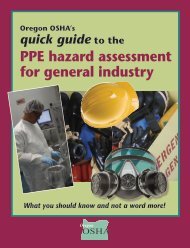Technical Manual - Section 3 (Safety Hazards)
Technical Manual - Section 3 (Safety Hazards)
Technical Manual - Section 3 (Safety Hazards)
You also want an ePaper? Increase the reach of your titles
YUMPU automatically turns print PDFs into web optimized ePapers that Google loves.
interaction of sulfur compounds in the hydrocarbons and the<br />
iron and steel in the equipment. On exposure to air (oxygen)<br />
it ignites spontaneously.<br />
QUENCH OIL Oil injected into a product leaving a<br />
cracking or reforming heater to lower the temperature and<br />
stop the cracking process.<br />
RAFFINATE The product resulting from a solvent<br />
extraction process and consisting mainly of those components<br />
that are least soluble in the solvents. The product recovered<br />
from an extraction process is relatively free of aromatics,<br />
naphthenes, and other constituents that adversely affects<br />
physical parameters.<br />
REACTOR The vessel in which chemical reactions take<br />
place during a chemical conversion type of process.<br />
REBOILER An auxiliary unit of a fractionating tower<br />
designed to supply additional heat to the lower portion of the<br />
tower.<br />
RECYCLE GAS High hydrogen-content gas returned to a<br />
unit for reprocessing.<br />
REDUCED CRUDE A residual product remaining after the<br />
removal by distillation of an appreciable quantity of the more<br />
volatile components of crude oil.<br />
REFLUX The portion of the distillate returned to the<br />
fractionating column to assist in attaining better separation<br />
into desired fractions.<br />
REFORMATE An upgraded naphtha resulting from<br />
catalytic or thermal reforming.<br />
REFORMING The thermal or catalytic conversion of<br />
petroleum naphtha into more volatile products of higher<br />
octane number. It represents the total effect of numerous<br />
simultaneous reactions such as cracking, polymerization,<br />
dehydrogenation, and isomerization.<br />
under carefully controlled conditions of temperature and<br />
oxygen content of the regeneration gas stream.<br />
SCRUBBING Purification of a gas or liquid by washing it<br />
in a tower.<br />
SOLVENT EXTRACTION The separation of materials of<br />
different chemical types and solubilities by selective solvent<br />
action.<br />
SOUR GAS Natural gas that contains corrosive,<br />
sulfur-bearing compounds such as hydrogen sulfide and<br />
mercaptans.<br />
STABILIZATION A process for separating the gaseous and<br />
more volatile liquid hydrocarbons from crude petroleum or<br />
gasoline and leaving a stable (less-volatile) liquid so that it<br />
can be handled or stored with less change in composition.<br />
STRAIGHT-RUN GASOLINE Gasoline produced by the<br />
primary distillation of crude oil. It contains no cracked,<br />
polymerized, alkylated, reformed, or visbroken stock.<br />
STRIPPING The removal (by steam-induced vaporization<br />
or flash evaporation) of the more volatile components from a<br />
cut or fraction.<br />
SULFURIC ACID TREATING A refining process in<br />
which unfinished petroleum products such as gasoline,<br />
kerosene, and lubricating oil stocks are treated with sulfuric<br />
acid to improve their color, odor, and other characteristics.<br />
SULFURIZATION Combining sulfur compounds with<br />
petroleum lubricants.<br />
SWEETENING Processes that either remove obnoxious<br />
sulfur compounds (primarily hydrogen sulfide, mercaptans,<br />
and thiophens) from petroleum fractions or streams, or<br />
convert them, as in the case of mercaptans, to odorless<br />
disulfides to improve odor, color, and oxidation stability.<br />
REGENERATION In a catalytic process the reactivation of<br />
the catalyst, sometimes done by burning off the coke deposits<br />
III:2-63
















